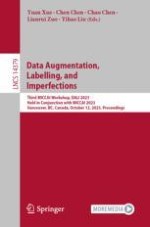2024 | Buch
Data Augmentation, Labelling, and Imperfections
Third MICCAI Workshop, DALI 2023, Held in Conjunction with MICCAI 2023, Vancouver, BC, Canada, October 12, 2023, Proceedings
herausgegeben von: Yuan Xue, Chen Chen, Chao Chen, Lianrui Zuo, Yihao Liu
Verlag: Springer Nature Switzerland
Buchreihe : Lecture Notes in Computer Science
